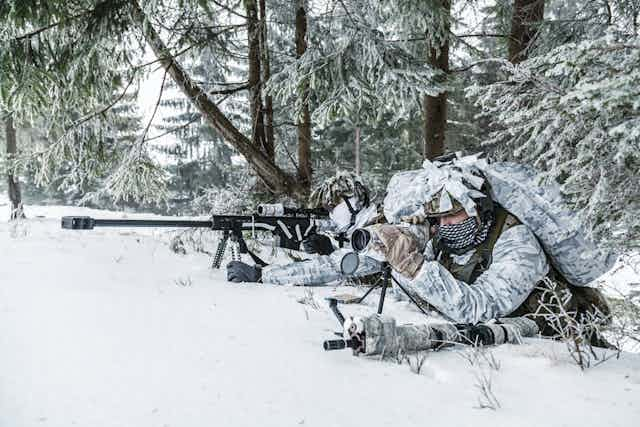All too often the Arctic region is portrayed as an area on the cusp of military crisis. This is an easy narrative to sell; it harks back to the Cold War. Potent imagery persists of submarines trolling silently beneath the Arctic ice and nuclear ballistic missiles pointed across the North Pole.
During the height of the standoff between NATO and the USSR, the world feared a barrage of nuclear warheads streaming in from the frozen north – and this experience has imprinted on the collective imagination and created distinct ideas about the region. This fear, for example, motivated from the 1950s the construction of the Distant Early Warning (DEW) Lines, a system of radar stations across the northern US (Alaska), Canada, and Greenland. The DEW Lines were meant to give the US and its NATO allies an early warning of an incoming Soviet nuclear strike.
The Cold War was a significant period in history. But catchy headlines playing off the parallels between the region and a new “cold” war are misleading. There have, of course, been increased tensions between the West and Russia since 2014 due to the conflict over Ukraine and Crimea. The 2018 Trident Juncture exercises in the Arctic, featuring “50,000 personnel from NATO Allies and partner countries”, are evidence of this. But the tension is not Arctic-specific and militaries are diverse actors in the region. This nuance, however, is often overlooked.
Current military exercises and equipment acquisitions fuel old Cold War perceptions. And a certain militarisation is indeed occurring in the Arctic. Russia, for example, has recently invested heavily in updating its northern military infrastructure. So too have other Arctic states, such as Canada and Denmark. But military activity has, to varying degrees, occurred for decades in the north – it was just largely ignored by those not living there until recently.
What’s changed?
The Arctic states guard their land and waterways through aerial, submarine and surface ship patrols, much as they have done for years. This hardly constitutes an escalation of military tensions, even if the infrastructure is being updated and, in some cases, increased. Despite this, talk of a new Cold War is heating up.
A nation’s armed forces often play a range of roles – beyond their traditional responsibilities in armed conflict. They are useful for rapid response during disasters, for example, and provide a range of security roles that don’t necessarily mean an escalation to war. They offer search and rescue (SAR) services and policing support.
In Norway, for example, the coastguard is one of the branches of the navy, along with the armed fleet, the naval schools and the naval bases. In Denmark, meanwhile, the coastguard’s Arctic activities are managed by the Royal Danish Navy.
In Canada, the coastguard is a civilian organisation. It “is the principal civilian maritime operational arm of the government of Canada”. But it also works closely with the Department of National Defence to provide Canada’s search and rescue services, including aerial support.

The US coastguard is part of the Department of Homeland Security, which “secures the nation’s air, land, and sea borders to prevent illegal activity while facilitating lawful travel and trade”. By law, however, the US coastguard is outside the Department of Defence “in peacetime and is poised for transfer to the Department of the Navy during war”.
Because of affiliations such as these, the line between military and civilian activity can become blurred. But that doesn’t mean all military activity is hostile or equates to an escalation towards war.
Changing environment
Climate change and technological advances have begun to open up the Arctic. And this means that more policing is required in a region that is remote and often out of reach for traditional police forces.
Other issues are also arising from climate change, such as increased forest fires. In July 2018, Sweden suffered major forest fires. As part of its effort to combat the fires it deployed “laser-guided bombs to douse forest fires”. This initiative was led by the Swedish air force. By using laser bombs, the “shockwaves simply blew out the flames in the same way our breath does to candles”.
As the region’s economic activity expands, armed forces are also being asked to assist more with civilian issues. In 2017, for example, the Norwegian coastguard was called in by local police in Tromsø to help police Greenpeace protesters who had entered a 500-metre safety zone around the Songa Enabler rig in an effort to stop drilling in the Korpfjell field of the Barents Sea. The Norwegian coastguard vessel, KV Nordkapp, responded, resulting in the seizure of Grenpeace’s Arctic Sunrise ship and the arrest of all 35 people on board.
Given the Arctic’s growing economic potential, military infrastructure is getting more attention. Russia, in particular, has made it clear that with economic potential on the line in the Arctic, a military build up is essential. For Russia, Arctic resources are central to the country’s economic security so the government line is: “National security in the Arctic requires an advanced naval, air force and army presence.” But issues of national security are wide ranging and are not solely a matter of building capacity to defend oneself from or in war.
Overall, it is vital to remember that while militaries are tools of war, they are not just tools of war. They also contribute to and provide a wide range of security services. This does not mean that increased military spending and activities should not be viewed with a critical eye. Indeed, they should. But discussing “a new Cold War” is sensationalist. It detracts from the broader roles that militaries play throughout the Arctic and stokes the very tensions it warns of.

